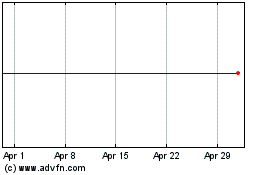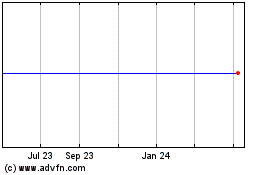Telesat’s Proposal in the Government of Canada’s Consultation on the Reallocation of 3800 MHz Spectrum Is the Best and Fa...
September 01 2020 - 7:00AM

Telesat, a leading global Canadian satellite operator, welcomes
Canada’s Ministry of Innovation, Science and Economic Development’s
(ISED) inclusion of Telesat’s innovative proposal to expeditiously
reallocate the highly desirable 3800 MHz, or “C-band,” mid-band
spectrum from fixed satellite use to 5G services in their recently
released consultation on the future of that band.
Telesat’s proposal is the only plan that ensures that sufficient
mid-band spectrum is made available on an expedited basis to
Canadian wireless operators, providing strong support to achieving
the Government’s objective of improved wireless affordability. In
addition, Telesat’s proposal fast-tracks affordable, high
throughput broadband connectivity to rural and remote Canadian
communities and places Canada at the forefront of the fast-growing
space industry by supporting the deployment of Telesat’s advanced,
state-of-the-art Low Earth Orbit (LEO) satellite constellation,
Telesat LEO.
Telesat, as the largest user of 3800 MHz, and the only satellite
operator licensed to use this spectrum in Canada, is proposing to
clear, on an expedited basis and in two phases, 400 MHz – or 80% –
of the mid-band spectrum so that it can be used for 5G
services. In doing so, Telesat will ensure that the vital,
mission-critical satellite services that must be relocated to clear
the 3800 MHz band for 5G use will be transitioned to other
satellite facilities at no cost and without interruption to the
current users.
“Telesat’s proposal to clear 3800 MHz spectrum is the only
actionable path to rapidly deploy true 5G service in Canada and to
connect rural and remote Canadian communities with fast, affordable
broadband, something we can achieve with the state-of-the-art
Telesat LEO satellite constellation,” said Dan Goldberg, Telesat’s
President and CEO. “In this regard, Telesat’s proposal will bring
tremendous economic benefits and job creation to Canada through 5G
and the fast-growing, export-driven New Space economy at a time
when affordable, universal broadband connectivity and economic
growth have never been more important. We welcome industry comments
on our proposal and the opportunity to demonstrate how our proposed
approach is in the best interests of all Canadians.”
Telesat launched services on 3800 MHz spectrum nearly 50 years
ago and is today using the full 500 MHz of mid-band spectrum to
provide hundreds of thousands of Canadians with broadcast video
content and critical lifeline services. These services include
telephone, wireless LTE, broadband connectivity, including remote
schools and health centres, and public safety and 911 capabilities
for satellite-dependent communities serving 50,000 Indigenous
Canadians. Telesat also uses the 3800 MHz spectrum to deliver
mission-critical services to a range of federal departments,
including Indigenous and Northern Affairs, National Defence, Nav
Canada, Fisheries and Oceans, the Coast Guard, the RCMP and Natural
Resources Canada.
Goldberg added, “Clearing 3800 MHz spectrum is a highly costly
and technically challenging endeavor. Our proposal is the only way
to clear this spectrum for 5G and ensure that all current satellite
users’ critical services remain connected during and after the
clearing process. We look forward to working with the current users
of C-band, the Canadian wireless providers, and other interested
parties in ensuring that our proposal is implemented in a manner
that supports the interests of current users while meeting the
expedited introduction of affordable 5G in Canada.”
ISED’s consultation can be reviewed here, and industry is
invited to submit comments until October 26, 2020.
About Telesat
Backed by a legacy of engineering excellence, reliability and
industry-leading customer service, Telesat has grown to be one of
the largest and most successful global satellite operators. Telesat
works collaboratively with its customers to deliver critical
connectivity solutions that tackle the world’s most complex
communications challenges, providing powerful advantages that
improve their operations and drive growth. Telesat LEO, our Low
Earth Orbit network will revolutionize global broadband
connectivity by delivering a combination of high capacity,
security, resiliency and affordability with ultra-low latency and
fiber-like speeds.
Privately held and headquartered in Ottawa, Canada with offices
and facilities around the world, Telesat’s principal shareholders
are Canada’s Public Sector Pension Investment Board and Loral Space
& Communications Inc. (NASDAQ: LORL). For more information,
visit www.telesat.com.
Media Contact:KWT Global PR for
Telesattelesat@kwtglobal.com646-989-8147
Forward-Looking Statements Safe Harbor
This news release contains statements that are
not based on historical fact and are ''forward-looking statements''
within the meaning of the Private Securities Litigation Reform Act
of 1995. When used in this news release, the words “will”, “can”,
“fast-growing”, and “proposal”, or other variations of these words
or other similar expressions are intended to identify
forward-looking statements and information. Actual results may
differ materially from the expectations expressed or implied in the
forward-looking statements as a result of known and unknown risks
and uncertainties. Detailed information about some of the known
risks and uncertainties is included in the "Risk Factors" sections
of Telesat Canada's Annual Report on Form 20-F for the fiscal year
ended December 31, 2019 and in Telesat Canada’s Quarterly Report on
Form 6-K for the quarters ending March 31, 2020 and June 30, 2020,
all of which can be obtained from the SEC website.
Known risks and uncertainties include but are
not limited to: risks associated with operating satellites and
providing satellite services, including satellite construction or
launch delays, launch failures, in-orbit failures or impaired
satellite performance, the impact of COVID-19 on
Telesat’s business and the economic environment, the ability to
successfully deploy an advanced global LEO satellite constellation,
the availability of government and/or other funding for the LEO
satellite constellation, the receipt of proceeds in relation to the
re-allocation of C-band spectrum, volatility in exchange rates, the
ability to expand our existing satellite utilization and risks
associated with domestic and foreign government regulation. The
foregoing list of important factors is not exhaustive. The
information contained in this news release reflects Telesat's
beliefs, assumptions, intentions, plans and expectations as of the
date of this news release. Except as required by law, Telesat
disclaims any obligation or undertaking to update or revise the
information herein.
Loral Space and Communic... (NASDAQ:LORL)
Historical Stock Chart
From Mar 2024 to Apr 2024

Loral Space and Communic... (NASDAQ:LORL)
Historical Stock Chart
From Apr 2023 to Apr 2024
